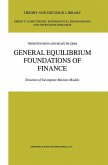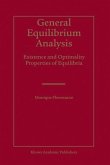General equilibrium In this book we try to cope with the challenging task of reviewing the so called general equilibrium model and of discussing one specific aspect of the approach underlying it, namely, market completeness. With the denomination "general equilibrium" (from now on in short GE) we shall mainly refer to two different things. On one hand, in particular when using the expression "GE approach", we shall refer to a long established methodolog ical tradition in building and developing economic models, which includes, as of today, an enormous amount of contributions, ranging in number by several 1 thousands - On the other hand, in particular when using the expression "stan dard differentiable GE model", we refer to a very specific version of economic model of exchange and production, to be presented in Chapters 8 and 9, and to be modified in Chapters 10 to 15. Such a version is certainly formulated within the GE approach, but it is generated by making several quite restrictive 2 assumptions - Even to list and review very shortly all the collective work which can be ascribed to the GE approach would be a formidable task for several coauthors in a lifetime perspective. The book instead intends to address just a single issue. Before providing an illustration of its main topic, we feel the obligation to say a word on the controversial character of GE. First of all, we should say that we identify the GE approach as being based 3 on three principles .
From the reviews: "They [authors] should be congratulated for their effort to present this apparatus in Part I of their book in a way that is as simple and transparent as possible, but without making compromises with regard to the required level of generality. I am not aware of any other text in economics that gives a comparable treatment. The book is required reading for anyone that would like to go beyond the traditional complete markets general equilibrium model, and that wants to have a deeper undestanding of the role played by financial markets. [...] it offers a complete account of the subject of incomplete markets, and I would therefore like to recommend it highly." (P.J.J. Herings, Maastricht University in Journal of Economics / Zeitschrift für Nationalökonomie, 81:3 (2004) "Although the book is written, as the authors say, for graduate students in an economics program and stops before really entering the core of differential topology, it is also interesting and profitable for mathematicians being involved with modern theoretical economic problems or applications of differential topology." (Alfred Göpfert, Zentralblatt MATH, Vol. 1103 (5), 2007)








